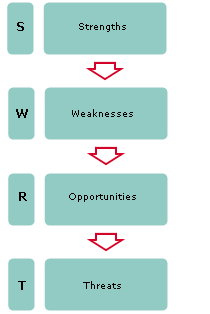
Conventional SWOT analysis is used to look at your Strengths, Weaknesses, Opportunities, and Threats in a situation. Stress SWOT Analysis will show you where you need to improve your stress management skills.
How SWOT Works
Carrying out the Stress SWOT Analysis ensures that you recognize all the personal strengths, skills, resources, and social networks that can help you to manage stress. You may find that you have strengths and skills that you are not aware of. This analysis will highlight them. By looking at your weaknesses, you identify areas you need to change in your life, including any new skills that you need to acquire. Listing opportunities enables you see how you can take advantage of your strengths to help you manage the stress in your life, and emphasizes the rewards of good stress management. By looking at the factors that are threats, you can recognize the negative consequences of managing stress poorly, and this should be a potent source of motivation.
Seek Support
Many people become stressed because they fail to recognize the resources at their disposal and the support network on which they can draw to help them to cope with stressful situations. It is important to recognize that very few people can do everything without help. Knowing how to recognize those situations where you should draw on the help available to you is an important part of stress management.
Carry Out Your Stress SWOT Analysis
With your stress diary at hand, run through the following procedure to identify your strengths and weaknesses, your opportunities and threats, and establish how you can harness this knowledge to manage stress in your life.
1 Write down your personal strengths:
-
People who are able to help you.
-
The resources you can draw on.
-
Times when you managed stress well, and the practical skills you used to do this.
2 Listing your personal weaknesses and the limitations of your position will help you to identify possible areas of change in your life and spot where you need to develop new skills. Write down:
-
Areas where you are aware that you are not strong, or things that people fairly criticize you for.
-
Problems with your job, your relationships, your living or working environment.
-
Times when you did not handle stress well, and why you think this was the case.
3 Think about the opportunities that are available to you:
-
Work your way through your strengths, and ask yourself how you can draw on these strengths to help you to manage stress.
-
Work through your weaknesses. Identify opportunities for positive change and the development of new skills.
-
Consider the practical opportunities that would be open to you if you were to take advantage of these opportunities to improve your stress management.
4 When considering your threats, think about the consequences of leaving your weaknesses uncovered, and about the damage to your relationships, career, and happiness that would result. Use this consideration of the downside as a spur to ensure that you take stress management seriously in the future!



